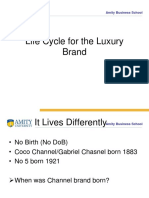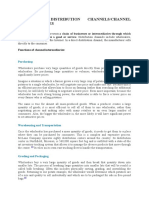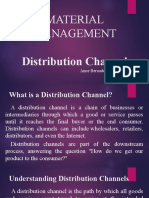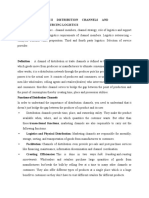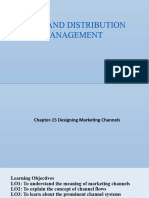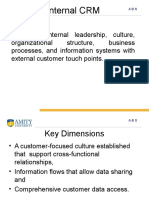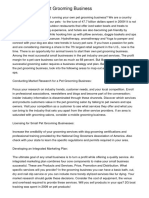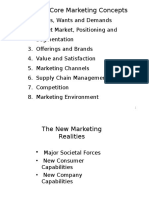Distribution
Distribution
Uploaded by
RahulRahejaCopyright:
Available Formats
Distribution
Distribution
Uploaded by
RahulRahejaOriginal Description:
Original Title
Copyright
Available Formats
Share this document
Did you find this document useful?
Is this content inappropriate?
Copyright:
Available Formats
Distribution
Distribution
Uploaded by
RahulRahejaCopyright:
Available Formats
Distribution:
Distribution Management is the management of all activities which
facilitates movement & co- ordination of demand & supply in
creation of time & place utility of goods & services.
Deals with the place part of the marketing mix. Helps gain sustainable
competitive advantage as the same is increasingly getting difficult through
product, price or promotion strategy.
Distribution Channels:
A distribution channel is a group of people & firms involved in the transfer of
title or ownership as the product moves from the producer to the end user. It
is the path or route along which goods move from producers or
manufacturers to ultimate consumers or industrial users. In other words, it is
a distribution network through which producer puts his products in the
market and passes it to the actual users. This channel consists of:
Producers, Consumers or Users and the various middlemen like
Wholesalers, Selling agents and Retailers(dealers) who intervene
between the producers and consumers. Therefore, the channel serves
to bridge the gap between the point of production and the point of
consumption thereby creating time, place and possession utilities.
The AMA defines the same as A structure of intra company
organization units & extra company agents, dealers, wholesalers &
retailers through which a commodity, product or service gets
marketed. They are the sets of interdependent organizations involved in the
process of making a product or service available for use or consumption.
Distribution channels can be broadly classified
into:
Producer-Customer
This is the simplest and shortest channel in which no middlemen is
involved and producers directly sell their products to the consumers. It
is fast and economical channel of distribution. Under it, the producer or
entrepreneur performs all the marketing activities himself and has full
control over distribution. A producer may sell directly to consumers
through door-to-door salesmen, direct mail or through his own retail
stores. Big firms adopt this channel to cut distribution costs and to sell
industrial products of high value. Small producers and producers of
perishable commodities also sell directly to local consumers.
Producer-Retailer-Customer
This channel of distribution involves only one middlemen called
'retailer'. Under it, the producer sells his product to big retailers (or
retailers who buy goods in large quantities) who in turn sell to the
ultimate consumers.This channel relieves the manufacturer from
burden of selling the goods himself and at the same time gives him
control over the process of distribution. This is often suited for
distribution of consumer durables and products of high value.
Producer-Wholesaler-Retailer-Customer
This is the most common and traditional channel of distribution. Under
it, two middlemen i.e. wholesalers and retailers are involved. Here, the
producer sells his product to wholesalers, who in turn sell it to retailers.
And retailers finally sell the product to the ultimate consumers. This
channel is suitable for the producers having limited finance, narrow
product line and who needed expert services and promotional support
of wholesalers. This is mostly used for the products with widely
scattered market.
Producer-Agent-Wholesaler-Retailer-Customer
This is the longest channel of distribution in which three middlemen
are involved. This is used when the producer wants to be fully relieved
of the problem of distribution and thus hands over his entire output to
the selling agents. The agents distribute the product among a few
wholesalers. Each wholesaler distribute the product among a number
of retailers who finally sell it to the ultimate consumers. This channel is
suitable for wider distribution of various industrial products.
Why are distribution channels needed?
In the past all distribution related operations were undertaken by the
company itself.
Soon they realized that the intermediaries could do the job better at a
much lower cost!
The intermediaries became a link between the manufacturer & its
customers.
Facilitate smooth flow and create time, place and possession utilities
Provide contact, experience, specialization and scales of operation
Discrepancies in marketplace
The distribution channel takes care of 4 discrepancies in the market place:
Spatial discrepancy : the difference between the location of a
producer and the location of widely scattered markets
Temporal discrepancy : A situation that occurs when a product is
produced but a customer is not ready to buy it
Breaking of the bulk
To provide assortment
Patterns of Distribution
Determines the intensity of the distribution
Intensity decides the service level provided
Types of distribution intensity:
1. Intensive distribution: Make sure that the product is made
available in as many outlets as possible. A form of distribution aimed at
having a product available in every outlet where target customers
might want to buy it. Strategy is to make sure that the product is
available in as many outlets as possible.
Preferred for consumer, pharmaceutical products and automobile
spares.
Distribution through every reasonable outlet available FMCG
2. Selective distribution: Only few select outlets will be permitted
to sell companys products. A form of distribution achieved by
screening dealers to eliminate all but a few in any single area. A few
select outlets will be permitted to keep the products. Outlets selected
in line with the image the company wants to project. It keeps
distribution costs lower
Preferred for high value products. E.g.: Tanishque jewelry
Multiple, but not all outlets in the market pharma, frozen food
3. Exclusive distribution: All the more selective, only one outlet in
the market may sell the companys product. A form of distribution that
establishes one or a few dealers within a given area. Highly selective
choice of outlets may be even one outlet in an entire market. Could
include outlets set up by companies Titan, Bata
May be only one outlet in a market, producer wants a close watch and
control on the distribution of his products - car dealers.
Types of channel members:
Distributors, dealers, stockists & agents
They are required to invest in products i.e. buy from company, are on
commission basis, may or may not get credit from the company. Name
denotes the extent of re-distribution done by them. Distributors invest in the
products buy products from the company. Distributors cover the markets as
per a beat plan. All others merely finance the business. Distributors could be
exclusive for a company while agents bring buyer and seller together.
Wholesalers
They deal in large volumes, as margin is quite low, operate out of the main
markets in the city, deals with large no. of companies products & packs.
They operate out of the main markets, deal with a number of company products
of their choice.
Are not on contract with any company. They sell to other wholesalers,
retailers and institutions.
Retailers:
They have final contact with consumers. They operate out of their shops and
sell a large assortment and variety of goods. Located closest to consumers.
Retailers buy from company, distributors or wholesalers. They have the
highest margins in the network and also provide personalised services to
their customers.
CFA s & CSAs:
C&FA: carrying and forwarding agent and C&SA: carrying and selling agent
both are on contract with a company. Both are transporters who work
between the company and its distributors. Collect products from the
company, store in a central location, break bulk and despatch to distributors
against indents. C&SA also sells the goods on behalf of the company but
remits proceeds after sale.
C&FA and C&SA also known as facilitators. Basically transporters who act
as a mid way point between the company & its distributors. CSA s act as
CFAs but also sell goods in the market & remit the value of goods sold to the
company
Functions performed by the intermediaries
Facilitation of search
Addresses the uncertainty part at both the consumers & manufacturers
end.
At times also enables sales of less known brands
Sort, Accumulate, Allocate& Assort the right kind of goods
Producers typically produces a large number of variety of goods, whereas
consumers only require limited quantity of wide variety of goods!
Routinisation of transactions
Helps in reducing the cost of distribution & increase the efficiency.
Enables flow of information to both the buyers & the sellers to help
them manage their business better
Reduction in the number of contact points
Awareness of the environment in which they operate
Channel Formats
Channel formats have been categorized into 4 types depending upon who
drives the channel. They are:
Producer driven
Seller driven
Service driven
Others
Producer driven
Manufacturer tries to reach the product directly to his customer eg
Company owned retail outlets, Licensed outlets, CSAs, franchisees.
Seller driven
Manufacturer uses the wholesalers & retailers to reach the end user eg
departmental stores, discount stores, specialty stores, supermarkets etc
Service Driven
CFAs, CSAs, transporters who facilitate distribution
Other formats
Multi level marketing system Amway, Tupperware, Co-operative societies,
catalogue shopping etc
Channel Levels
The number of channel members decides the level of channel in operation.
Zero level channel denotes direct distribution set up.
One level channel consists of one intermediary only. ( retailer)
Two level channel would have two intermediaries ( distributors then
retailers)
Prominent channel systems
1) Vertical Marketing system (VMS) :
Various parties like producers, wholesalers and retailers act as a unified system to
avoid conflicts. This system Improves operating efficiency and marketing
effectiveness. There are 3 types of VMS:
i.
ii.
iii.
Corporate
Administered
Contractual
Corporate VMS
Combines successive stages of production and distribution under single ownership
Examples :
Bata, Bombay Dyeing, Raymond
Sears, Goodyear
Suppliers of food items could be also their own supplying firms - like Nilgiris
Administered VMS
Co-ordinates distribution activities
Gains market power by dominating a channel
Usually true of dominant brands like GE, Kodak, Pepsi, Gillette, Coke and HLL
in certain locations
Command high level of co-operation in shelf space, displays, pricing policies
and promotion strategies
Contractual VMS
Independent producers, wholesalers and retailers operate on a contract
Could take the forms of:
Wholesaler sponsored voluntary chains
Retailer co-operatives
Manufacturer sponsored retail or wholesale franchise
Franchise organizations
Service firm sponsored retail franchise
2) Horizontal marketing system ( HMS)
Two or more unrelated companies join together to pool resources and exploit
an emerging market opportunity
In-store banking in hotels, big stores
Retail outlets in petrol bunks
Coffee Day outlets in airports
3) Multi- channel marketing system
Used in situations where :
Same product but different market segments
Unrelated products in same market detergents and ice creams (HLL)
Size of buyers varies
Geographic concentration of potential consumers varies
Reach is difficult
You might also like
- The Secret Jewels of FMCG Retail distribution & Channel salesFrom EverandThe Secret Jewels of FMCG Retail distribution & Channel salesRating: 3.5 out of 5 stars3.5/5 (3)
- Distribution Channel of PepsicoDocument44 pagesDistribution Channel of PepsicoDevesh SharmaNo ratings yet
- LUXURY Retail - Life Cycle For The Luxury BrandDocument4 pagesLUXURY Retail - Life Cycle For The Luxury BrandRahulRahejaNo ratings yet
- Channels of DistributionDocument13 pagesChannels of DistributionFredrick Mwesigye50% (2)
- ss2 Marketing NoteDocument12 pagesss2 Marketing Notepheonixflames456No ratings yet
- Channels of DistributionDocument6 pagesChannels of DistributionҚang PrietyyNo ratings yet
- Channels of DistributionDocument4 pagesChannels of Distributionakhilthambi123No ratings yet
- Unit 5Document13 pagesUnit 5Dr. Kainat Akhtar UsmaniNo ratings yet
- Final Logistic ProjectDocument22 pagesFinal Logistic ProjectNidhi NirmalNo ratings yet
- CHP 8 - Channels of Distribution, Logistics, and WholesalingDocument9 pagesCHP 8 - Channels of Distribution, Logistics, and WholesalingTino AlappatNo ratings yet
- The Main Affecting Factors AreDocument4 pagesThe Main Affecting Factors AreNirav KapadiaNo ratings yet
- SDM Unit-4Document38 pagesSDM Unit-4harshbaghel656No ratings yet
- Distribution ChannelsDocument22 pagesDistribution Channelsranakritika1820No ratings yet
- Distribution ChannelDocument15 pagesDistribution Channelmohseen619No ratings yet
- PROJECT REPORT 1 - ChannelDocument5 pagesPROJECT REPORT 1 - ChannelAnuNo ratings yet
- Distribution StrategyDocument9 pagesDistribution StrategyKomal Shujaat100% (6)
- Unit 13: Channels of Distribution, Logistics, and WholesalingDocument7 pagesUnit 13: Channels of Distribution, Logistics, and WholesalingPraharsh ShahNo ratings yet
- Unit 5 Distribution Planning & ControlDocument13 pagesUnit 5 Distribution Planning & ControlSusmi SusmithaNo ratings yet
- SDM Unit IiiDocument14 pagesSDM Unit Iiisasid748No ratings yet
- Distribution DecisionsDocument18 pagesDistribution DecisionsAMOS WASIKENo ratings yet
- Concept of ChanelDocument7 pagesConcept of ChanelChetan Ganesh RautNo ratings yet
- SMDocument7 pagesSMShashi SharmaNo ratings yet
- Types of DistributorsDocument6 pagesTypes of DistributorsRosHan Awan100% (1)
- Channels of DistributionDocument9 pagesChannels of DistributionSupreet Singh BediNo ratings yet
- Business Marketing ReviewerDocument3 pagesBusiness Marketing Reviewercali kNo ratings yet
- MM - Module 4Document22 pagesMM - Module 4fahminiyas1234No ratings yet
- 2-Distribution ChannelDocument33 pages2-Distribution Channeleddushailaja177No ratings yet
- Selling To Distribution ChannelsDocument6 pagesSelling To Distribution ChannelsShreya ChavanNo ratings yet
- 2.1 Concepts of Distribution Channels: Distribution Channel (Channel of Distribution) Is A Set of InterdependentDocument10 pages2.1 Concepts of Distribution Channels: Distribution Channel (Channel of Distribution) Is A Set of Interdependentvishnunair101010No ratings yet
- AssignmentDocument11 pagesAssignmentMuhammad MuazzamNo ratings yet
- Distribution SystemDocument21 pagesDistribution SystemHema Sharma100% (1)
- Uni-IV - Chennel of DistributionsDocument5 pagesUni-IV - Chennel of Distributionsguriya khanNo ratings yet
- Effectiveness and Efficiency of Distribution Channels in FMCGDocument23 pagesEffectiveness and Efficiency of Distribution Channels in FMCGsshreyasNo ratings yet
- Channel Decisions 3-9-2022Document36 pagesChannel Decisions 3-9-2022Sarvagya ChaturvediNo ratings yet
- Distribution ChannelDocument5 pagesDistribution ChannelNorilyn Florin-AlapadNo ratings yet
- Marketing MGT12Document44 pagesMarketing MGT12Bilal AdibNo ratings yet
- 105-BOM-DC & Promotion Notes (Unit-5)Document8 pages105-BOM-DC & Promotion Notes (Unit-5)S.G. GroupNo ratings yet
- Marketing Distribution ChannelsDocument3 pagesMarketing Distribution ChannelsVishal SoniNo ratings yet
- 8 DistributionDocument33 pages8 Distributionj8x4sbgdjbNo ratings yet
- Module 6 Notes - Marketing ManagementDocument11 pagesModule 6 Notes - Marketing ManagementAniruddh ChavanNo ratings yet
- SDM 4Document15 pagesSDM 4Anonymous 9oL9HS0% (1)
- Marketing ChannelDocument3 pagesMarketing Channeldiumano123No ratings yet
- Mangalayatan University: Distribution ChannelDocument6 pagesMangalayatan University: Distribution ChannelGaurav Singh RajpootNo ratings yet
- Place & Distribution by Prof. Rashmi PhirakeDocument45 pagesPlace & Distribution by Prof. Rashmi PhirakeHarshal ShejwalkarNo ratings yet
- Control Techniques For SalesDocument19 pagesControl Techniques For SalesGanesh RawoolNo ratings yet
- The Importance of Distribution, Types and Types of ConflictDocument8 pagesThe Importance of Distribution, Types and Types of Conflictrohan_jangid8No ratings yet
- Report - Material ManagementDocument16 pagesReport - Material ManagementAnne Bernadette SumugatNo ratings yet
- Definition of Key Terms: DownstreamDocument8 pagesDefinition of Key Terms: DownstreamAnonymous wMppXCM0No ratings yet
- MM 4th Module NotesDocument20 pagesMM 4th Module NotesRajesh KNo ratings yet
- Chapter 14 DistributionDocument21 pagesChapter 14 DistributionSoniaNo ratings yet
- Assortments. Wholesalers and Retailers Purchase Large Quantities of Goods FromDocument26 pagesAssortments. Wholesalers and Retailers Purchase Large Quantities of Goods FromGaayathri MNo ratings yet
- Unit 7 Channels of DistributionDocument14 pagesUnit 7 Channels of DistributionKritika RajNo ratings yet
- Distribution ChannelsDocument34 pagesDistribution ChannelsNirmala Crasto100% (1)
- Channel Decisions 9-8-2019Document22 pagesChannel Decisions 9-8-2019jatin yadavNo ratings yet
- Unit 3 Place and PromotionDocument122 pagesUnit 3 Place and PromotionRishit GoelNo ratings yet
- What Is A Distribution ChannelDocument2 pagesWhat Is A Distribution ChannelLiwart RobstenNo ratings yet
- Chapter 15Document18 pagesChapter 15RAVI SINGHNo ratings yet
- Resume Bisnis Chapter 13 & 14 Karin Annisa Riyadi - 202170028 Distribution Channels and Market CoverageDocument19 pagesResume Bisnis Chapter 13 & 14 Karin Annisa Riyadi - 202170028 Distribution Channels and Market CoverageKarin AnnisaNo ratings yet
- Channel Distribution Sales and ManagementFrom EverandChannel Distribution Sales and ManagementRating: 3 out of 5 stars3/5 (2)
- Dropshipping: Make Money Online & Build Your Own Dropshipping Business (Step-by-step Instructions for Starting E-commerce Business and Making Money Online)From EverandDropshipping: Make Money Online & Build Your Own Dropshipping Business (Step-by-step Instructions for Starting E-commerce Business and Making Money Online)No ratings yet
- Wal-Mart Stores, Inc., Global Retailer case study, the GUIDE editionFrom EverandWal-Mart Stores, Inc., Global Retailer case study, the GUIDE editionNo ratings yet
- Overview of Financial Services in IndiaDocument2 pagesOverview of Financial Services in IndiaRahulRaheja100% (1)
- LUXURY Retail - 6 P's of Luxury MarketingDocument8 pagesLUXURY Retail - 6 P's of Luxury MarketingRahulRahejaNo ratings yet
- 4ba9cmodule 2-Part1 PDFDocument55 pages4ba9cmodule 2-Part1 PDFAditya ChoudharyNo ratings yet
- Selling ProcessDocument17 pagesSelling ProcessRahulRahejaNo ratings yet
- Internal CRMDocument10 pagesInternal CRMRahulRahejaNo ratings yet
- Barriers To Effective CommunicationDocument26 pagesBarriers To Effective CommunicationRahulRahejaNo ratings yet
- 14e GNB ch01 SMDocument7 pages14e GNB ch01 SMOmerGull100% (1)
- Start Your Own Pet Grooming BusinessDocument2 pagesStart Your Own Pet Grooming BusinessSilva12DanielNo ratings yet
- Economical Optimization of .ArongDocument23 pagesEconomical Optimization of .ArongemonenjoyNo ratings yet
- CH-10: Plant Assets, Natural Resources, and Intangible AssetsDocument44 pagesCH-10: Plant Assets, Natural Resources, and Intangible AssetsMohammed Merajul IslamNo ratings yet
- Adyen Shareholder Letter FY23 H2Document49 pagesAdyen Shareholder Letter FY23 H2Ashutosh DessaiNo ratings yet
- B2B Prospecting Challenges: From The Front LinesDocument23 pagesB2B Prospecting Challenges: From The Front LinesAmit MulikNo ratings yet
- Adjusting Entries Quiz 2Document25 pagesAdjusting Entries Quiz 2Chris MartinezNo ratings yet
- International Marketing Plan EDENDocument9 pagesInternational Marketing Plan EDENBeatriceNo ratings yet
- Multiple Choice: Accounting Information Systems: An..Document4 pagesMultiple Choice: Accounting Information Systems: An..Ali ArnaoutiNo ratings yet
- About V MartDocument2 pagesAbout V MarttrivanmayurNo ratings yet
- Case 5 Ford MotorDocument8 pagesCase 5 Ford MotorVani ChellAm100% (1)
- Unit 4Document52 pagesUnit 4tempacc9322No ratings yet
- Problems and Questions - 3Document6 pagesProblems and Questions - 3mashta04No ratings yet
- Coffee Export Business PlanDocument38 pagesCoffee Export Business PlanYitbarek MohammedNo ratings yet
- Supply Chain Drivers: OutlineDocument15 pagesSupply Chain Drivers: OutlineLive StreamNo ratings yet
- Bottle Grounds-4ps, SWOT, Market SegmentationDocument12 pagesBottle Grounds-4ps, SWOT, Market SegmentationMark XiarwilleNo ratings yet
- Marketing ConceptsDocument64 pagesMarketing ConceptsMohit ChoudharyNo ratings yet
- SEC Subpoena MGT Capital September 2016Document14 pagesSEC Subpoena MGT Capital September 2016Teri Buhl100% (1)
- ACCA (F1) BT - FBT Syllabus and Study Guide - FinalDocument10 pagesACCA (F1) BT - FBT Syllabus and Study Guide - FinalFakeprofile HdNo ratings yet
- Applied Econ Week 1 4THDocument4 pagesApplied Econ Week 1 4THjgpanizales03No ratings yet
- Objectives of SebiDocument5 pagesObjectives of Sebicherry0% (1)
- HO Model NotesDocument7 pagesHO Model NotesecsNo ratings yet
- Module 5 - PpsDocument4 pagesModule 5 - PpsMIGUEL JOSHUA VILLANUEVANo ratings yet
- Rewards of Going Into Business or EntrepreneurshipDocument22 pagesRewards of Going Into Business or Entrepreneurshipjoshuabarrera1999No ratings yet
- Pricing Strategies For Each Stage of PLCDocument9 pagesPricing Strategies For Each Stage of PLCYedhu KNo ratings yet
- 24 Aud Prob A 03Document2 pages24 Aud Prob A 03Janette EvaleNo ratings yet
- 0309 BdmsDocument4 pages0309 BdmscoolartncraftsNo ratings yet
- Production and Operations ManagementDocument121 pagesProduction and Operations ManagementAllen KateNo ratings yet
- MarketingDocument25 pagesMarketingEnockNo ratings yet
- Chapter 3 Governance ICDocument32 pagesChapter 3 Governance ICFatma AbdelnaemNo ratings yet


